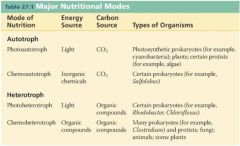![]()
![]()
![]()
Use LEFT and RIGHT arrow keys to navigate between flashcards;
Use UP and DOWN arrow keys to flip the card;
H to show hint;
A reads text to speech;
40 Cards in this Set
- Front
- Back
|
BINARY FISSION
|
-asexual reproduction
-genetically identical offspring -allows for exponential growth |
|
|
Generation (doubling time)
|
-the amount of time it takes bacteria every time it divides and reproduces
-varies from species to species |
|
|
BIOFILM and its importance
|
-polymer encased microbial community
-bacteria grows on a surface -sense and responds to environmental change, interacts with organisms in complex communities |
|
|
PURE CULTURE
|
-single species from once cell
-used in laboratories -can behave differently than in natural habitat -only 1% have been cultured |
|
|
Bacterial Growth Curve
|

-applies to liquid cultures
-lag phase -exponential (log) phase -stationary phase -death phase -phase of prolonged decline |
|
|
Lag Phase
|
-not much growth
-starting, small population -building macromolecules needed to produce more -length depends on starting pop & richness of nutrients |
|
|
Exponential (log) Phase
|
-population doubles every generation
-synthesis of 1* metabolites (required for growth) |
|
|
Stationary Phase
|
-growth is 0
-# new cells = # of dying cells - 2* metabolites (toxins, etc) |
|
|
Death Phase
|
-# new cells < # dying cells
-fairly constant rate of decline |
|
|
Phase of Prolonged Decline
|
-remaining bacteria are the most "fit"
-quick evolution of population |
|
|
What is optimal growth temperature?
|
-temperature at which organism multiplies most rapidly
-enzymes determine optimal temp |
|
|
Does freezing or chilling food kill most bacteria? Why?
|
-No
-Enzymes work better at higher temperatures -cold slows them down -membrane gels, growth slows or doesn't occur |
|
|
Does high heat kill most bacteria? Why?
|
-yes
-high heat denatures the enzymes -causes cell to collapse, thermal lysis |
|
|
PSYCHROPHILES
|
-cold lovers
-10*C |
|
|
PSYCHROTROPHS
|
-can grow in cold
-25*C, room temp |
|
|
MESOPHILES
|
-warm lovers
-37*C, body temp |
|
|
THERMOPHILES
|
-heat lovers
-60-70*C |
|
|
HYPERTHERMOPHILES
|
-really heat lovers
-90-100*C -very resistant to denaturing |
|
|
How do prokaryotes survive in extreme pH environments?
|
-enzymes adapted to survive
-can control # p+ in cells |
|
|
How do some bacteria prevent plasmolysis in hypertonic environments?
|
-pump ions so cell concentration is similar to environment, prevent osmosis
|
|
|
How can oxygen be toxic to a cell?
|
-oxygen oxidizes cells, takes e-
-anaerobic microbes cannot produce enzymes to protect from oxidation -(superoxide dismutase, catalase) |
|
|
Describe the roles of superoxide dismutase and catalase in oxygen utilization and/or intolerance
|
-protection from oxidation if have enzymes
-superoxide dismutase catalyzes superoxide into hydrogen peroxide and oxygen -catalase breaks hydrogen peroxide into water and oxygen |
|
|
Obligate aerobes
|
-need oxygen to survive
-& to produce energy in ETC -have both enzymes |
|
|
Obligate anaerobes
|
-No oxygen, anaerobic respiration
-DON'T have the enzymes |
|
|
Facultative anaerobes
|
-can live w/out oxygen by doing fermentation
-prefers oxygen -have both enzymes |
|
|
Microaerophile
|
-small amount of oxygen (2-10%)
-produces catalase sometimes -cant survive in too little or too much oxygen |
|
|
Aerotolerant aerophiles
|
-(obligate fermenters)
-only do fermentation -can survive in oxygen |
|
|
Neutrophiles
|
- pH 5-8 (body pH)
|
|
|
acidophiles
|
- pH <5
|
|
|
alkalophiles
|
- pH > 8
|
|
|
facultative
|
-optional
-can have, but not neccesary |
|
|
Obligate
|
-need to survive
|
|
|
Major nutritional modes
|

photoautotrophs- photosynthesis
photoheterotrophs- only prokaryotes chemoautotrophs- only prokaryotes chemoheterotrophs- us |
|
|
sterilization
|
-highest level of bacterial control
-kill all microorganisms, bacteria, viruses, endospores -heat, chemicals, irradiation, filtration |
|
|
Disinfection
|
-gets rid of things that cause pathogens, things that cause disease
-disinfectant- surfaces ex. bleach, lysol -antiseptic- skin ex. hydrogen peroxide, isopropyl alcohol |
|
|
Pasteurization
|
-brief heat treatment
-reduce bacteria that would spoil food or containers |
|
|
Physical methods of microbial growth control and applications
|
HEAT
*moist- boiling- low tech inexpensive destroys most organisms and viruses, doesn't destroy endospores -pasteurization- significant reduces organisms, increase shelf life -pressurized steam- autoclave *Dry- not as effective, requires longer times and higher temps-incineration- burning -membrane filtration- fine filter traps bacteria and viruses liquid or air -radiation- zap w/ UV light- used for food ionizing or non -pressure- denatures proteins, uses less heat |
|
|
Chemical methods of microbial growth control and applications
|
-(antiseptics/disinfectants)
-germicidal chemicals -reacts with vital cell sites -liquids- alcohol -gas- ozone |
|
|
Describe how food products and other products can be preserved by preventing the growth of microbes
|
-breads, cheeses, juices preserved by adding weak organic acids
-meats processed with nitrite or nitrate inhibit growth of endospores -refrigeration inhibits growth by slowing or stopping enzyme reaction -freezing stops microbial growth but some can survive and spoil once thawed -salting and drying decreases availability of water in food below limits required for growth of most microbes, high concentration causes plasmolysis -adding salt or sugar dehydrates cells |
|
|
plasmolysis
|
shrinking of the cytoplasm of a plant cell due to the diffusion of water out of the cell into a hypertonic solution
|

